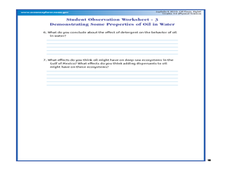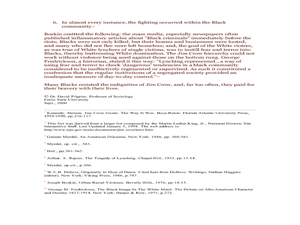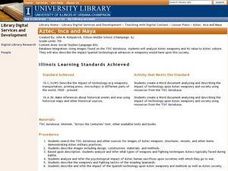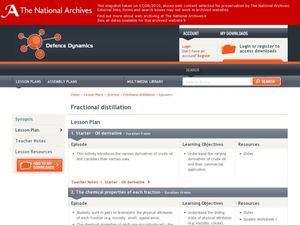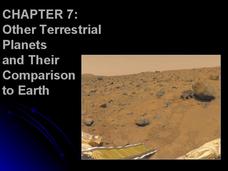Curated OER
Oil Floats, Right?
Students examine the properties in oil in water. In this mixture lesson, students read about the Lophelia II 2010: Cold Seeps and Deep Reef Expedition and look at images of deep sea ecosystems. They experiment or participate in...
Curated OER
Mapping National and Geographic Identity
Students analyze geographic maps. In this map analysis lesson plan, students analyze the symbols in geographic maps and the impact of cultural, historical, and political concepts. Students compare and contrast maps in various mediums by...
Curated OER
Goddess Worship in a Modern Perspective
Students consider gender roles and religion. In this gender equality lesson, students compare and contrast the idea of patriarchal and matriarchal religious practices and how they impacted society. Students will pose questions and...
Curated OER
Television Goes Digital
Students explore the difference between analog and digital televisions. They examine how the technology works and the impact of television through history. They also compare older television sets to ones found today.
Curated OER
Close Enough?
Students examine how navigation is based on mathematics and how making a mistake in measuring an angle could have an impact on a target. They observe a teacher-led lecture, use a calculator to complete two worksheets, and participate in...
Curated OER
Romeo and Juliet: Insight into Ourselves
Students research the historical background of Romeo and Juliet as well as Shakespeare's time to better understand the play. Students work in teams to make plans and products targeting their chosen issues to positively impact their...
Curated OER
The Massachusetts 54th Regiment: Honoring the Heroes
Students use art and images analyze the Civil War. In this lesson plan on the Shaw Memorial, students engage in 3 activities, discussion, and art analysis to better comprehend the events of the Civil War. This lesson plan includes web...
Curated OER
The Rise and Fall of the Jim Crow Era
Students explore African American history by researching the Jim Crow laws. In this Civil Rights lesson, students define the Jim Crow laws, the reasons they were put into place, and how they were ultimately defeated. Students write a...
Curated OER
Aztec, Inca, and Maya
Seventh graders use images of Aztec weaponry to analyze its' value. They create a Word Document with the information.
Curated OER
Fractional Distillation
Students brainstorm the different uses of petroleum distillates. In this chemistry instructional activity, students explain the process of fractional distillation. They analyze the impact of oil extraction to the environment.
Curated OER
In the Footsteps of West Virginia
Students prepare for a visit to the West Virginia State Museum. In this West Virginia history lesson, students research the individuals whose leadership impacted the state. Students create multimedia projects featuring the individuals...
Curated OER
Living on a Cotton Farm: Mexican Americans Life In Texas
Seventh graders are introduced to the processes of cotton farming in the early 20th century. In groups, they examine the role of Mexican Americans on the farms and the impact of a boom and bust economy on cotton. They identify the...
Curated OER
Out of the Mud
Eleventh graders explore the impact the automobile had on Iowans and their ways of life. In this technology lesson plan, 11th graders research how Iowans promoted "Good roads" and the reasons for paving roads.
Curated OER
Microbial Spoilers: The Impact of Microorganisms on the Shelf-life of Milk
Students are inroduced to a commonly used microbial culturing technique. They explore the role of microorganisms in determining the shelf-life of food products.
Curated OER
The Global Precipitation Measurement Mission (GPM) Lesson
Introduce your class to one of the ways that technology is benefiting humanity. The Global Precipitation Measurement Mission involves the data collected by nine satellites from different countries with a united focus on studying world...
NOAA
Where Have All the Glaciers Gone?
What happens when ice melts? Well ... water happens. When that melting ice is a glacier, the amount of water that results produces change throughout the world. Middle school science sleuths uncover the truth about global warming, the...
Glynn County School System
Terrestrial Planets
Mercury, Venus, Earth, and Mars are collectively known as the terrestrial planets. Although part of the same group, each planet has its own set of characteristics. Scholars explore the characteristics that make the planets unique and...
Southern Nevada Regional Professional Development Program
Reading Literature - The Ruin
Cross-comparison, the technique of focusing on two different texts with the same themes, motifs, events, etc., is employed in an exercise that asks groups to examine two different translations of “The Ruin,” a poem, written in Old...
School Improvement in Maryland
Executive Order
After reading information about Executive Order #9066, class members assume the voice of an 18 year-old Japanese-American born in California and placed in an internment camp. Individuals then craft a letter to President Roosevelt...
Museum of the Moving Image
AdMaker, Nixon vs. Humphrey, “Convention” (1968)
After viewing the infamous 1968 Presidential campaign ad, "Convention," groups use AdMaker to create their own 30 second ad that features Richard Nixon rather than Hubert Humphrey.
Glynn County School System
Earth's Magnetic Field and the Moon
The surface of the moon has an amazing tale to tell. Learn about the moon's story with a PowerPoint presentation that describes the unique features of the moon's surface as well as explains its movement in relation to Earth.
George Washington's Mount Vernon Estate & Gardens
George Washington: Centerpiece of a Nation
A neat Presidents Day activity, this lesson provides a culminating learning experience for upper elementary aged learners. After analyzing George Washington's, "A Display of the United States of America," your learners will conduct...
Polytechnic Institute of NYU
Potential vs. Kinetic Energy
Legos in science class? Watch your pupils fall in love with this activity. After learning to measure potential and kinetic energy, young scientists create their own ramps using Lego Mindstorm sensors and software.
J. Paul Getty Trust
Shaping Ideas: Symbolism in Sculpture—Lesson 2
Young artists create a series of sketches of ideas for a sculpture, and using the criteria develop in the previous class, critique their sketches. They then choose one of their ideas and create their work of art.


